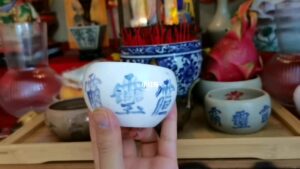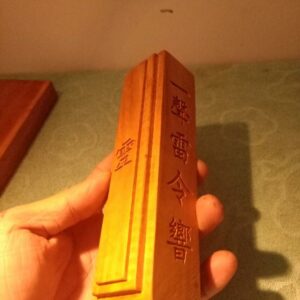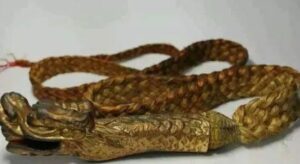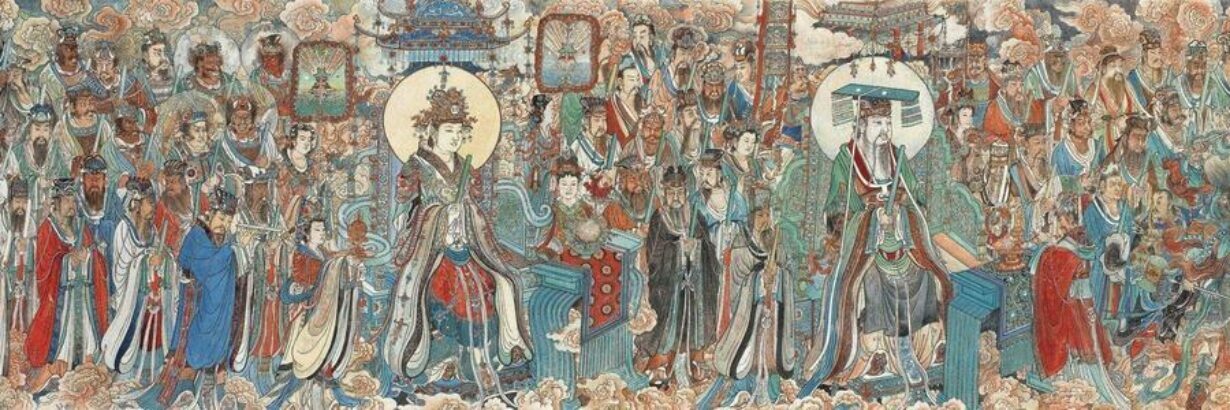Daoists, same like any other craftsmen use tools to work. Their artifacts and sacred items often passed down from generation to generation and are empowered by spirits. The so called Fǎ Qì 法器 are categorized into Ritual items and Ritual Instruments.
Some Fǎ Qì 法器 are used to develop skills and cultivate Dao, other are used during ceremonies and rituals. The priests use the artifacts to command and communicate with the spiritual world.
Depending on the tradition there are several items more commonly used by practitioners of one school than by those from another. In Part 1 we introduce the commonly used Ritual Items.
Ritual Items
Hù 笏:

Also called Cháo Jiǎn 朝简, Cháo Bǎn 朝板 or Cháo Hù 朝笏. Daoists use it to pray, pay respects and honour the Gods and Immortals. One could stick notes onto the Hù 笏 so the priest remember what to say. In ancient time the officers and ministers used it to speak infront of the emperor. That time the emperor used Hù 笏 made of jade, prince and highest ministers used ivory made Hù 笏 and normal officers used bamboo made. During the Daoist Ceremony the priest is holding the Hù 笏 infront of him/her to step infront of the altar and communicate with the deity.
Rú Yì 如意:
Usually made of jade, wood or bone it is slightly bend like the character for heart (Xīn 心). There are three charactaristic parts of the Rú Yì 如意. They have the shape of clouds and/or Zhī 芝 at top and bottom ends, and are rounded in the middle part. It represents the three clearities or three treasures Dào Bǎo 道宝(Dao), Jīng Bǎo 经宝(Scriptures), Shī Bǎo 师宝(Master). It is often used by the higher masters or abbots of a temple during rituals or transmissions.
Fǎ Yìn 法印 :
Ritual-Seal are mostly made of wood, copper or jade. On the seal side there are usually Chinese characters, Daoist writings or symbols, or even complete Fú 符 talisman. On the handle side we sometimes find what seal it is and the handle itself is sometimes shaped like a lion, tiger or other evil expelling beeings. Daoism started using Ritual-Seal from the time of the first Tiān Shī 天师 (Heavenly Master ) Zhāng Dào Líng 张道陵 and still use it today. The Ritual-Seal is one of the most important Daoist artifacts and it is used to command spirits, and to empower talisman and registers. Written in the Dong Xuan Scripture 洞玄经 it says: 法印照处,魅邪灭亡 Fǎ yìn zhào chù, mèi xié miè wáng, meaning: Where the Ritual-Seal is used, the evil spirits are perishing.”
Fǎ Jiàn 法剑:
Also called Bǎo Jiàn 宝剑 (Treasure Sword), Lìng Liàn 令剑 (Commanding Sword) or Qī Xīng Jiàn七星剑 (Seven Star Sword). On the blade made of steel there are engravings of the seven stars of the big dipper on both sides of the sword and dragon, tiger or talisman patterns on the handle.
The sword is a powerful magic weapon for slashing and killing demons. Zhang Tian Shi’s family treasures are the sword and the seal of the Heavenly Master. Usually the seven-star sword with a thin blade is used in one hand. Sometimes it can be split and held in two hands, then it is also called a double sword or a combined sword. There is also a wooden sword with a spell engraved on the sword. Many wood swords are carved from peach wood, which then is also called peach wood sword (Táo mù jiàn 桃木剑).
Lìng Pái 令牌:
Also known as Léi Lìng 雷令 or Wǔ Léi Hào Lìng 五雷号令. It is a wooden token with a rounded top and a flat bottom. These both sides represent the heaven and the earth. The names of the twenty-eight stars are engraved on the sides. The token is a sacred tool for the Daoist priests to command spirits during the rituals. The shapes and patterns of the Lìng Pái 令牌 can differ from different traditions to different rituals. Sometimes one kind is used for a specifict ritual only while others are commonly used for many different ceremonies.
There are many types of Lìng Pái 令牌. They can differ in shape and size. Some are engraved with dragons or swords, and some are engraved with the command of the five thunders and the summoning of the gods.
Gān Lù Wǎn甘露碗:
Also called water bowl or water cup. It is used to keep the holy water during the ceremony. The water is also called Gān Lù 甘露 (nectar). In ancient times, it was made of bamboo, but now it is mostly made of brass or porcelain. The vessel is shaped like a teacup, with a slightly larger mouth, and often the symbols of the five sacred mountains are painted around the cup. There are also rice bowl-shaped water bowls with a slightly narrow mouth. During the ceremony the priest often holds the cup in the left hand and the willow or bamboo branch in the right hand, soaking it in the holy water and spreading it around the altar to clean the area. “灵宝济度金书 Golden Book of Lingbao Jidu” states: “Willow branches sprinkle (holy water) to clean the karma and relieve from dirt and dust of the shapeless.” Sometimes it symbolizes the spreading of holy nectar to save the souls of the dead.
Zhèn Tán Mù 镇坛木:
Also known as Zhèn Tán Mù 震坛木, Fèng Zhǐ 奉旨, Jìng Bǎn 净板, etc. It is a wooden block for the altar with a rectangular shape. The top surface is slightly rounded and the bottom surface is flat. It is usually painted red with lacquer. The four characters Wàn Shén Xián Tīng 万神咸听 are engraved on the front, and the four hexagrams Qián 乾 Kūn 坤 and Kǎn 坎 Lí 离 are engraved on both ends. During the ceremony the Zhen Tan Mu is placed on the altar and used by the priest to do the ritual. When Daoists specialize in magic arts, the Zhen Tan Mu is also used to slap on the tabletop to intimidate evil spirits.
Kǎo Guǐ Bàng 拷鬼棒:
Also known as Dǎ Guǐ Bàng 打鬼棒 and Gǎn Guǐ Bàng 赶鬼棒 is a Daoist artifact often used during the ceremonies and rituals. It had the shape of a cane which became a short stick in modern times. On the stick are Talisman (Fú Zhuàn 符篆) engraved.
Jīn Qián Jiàn 金钱剑:

The money sword is used by Daoist masters to catch ghosts and subdue demons. It can also be hung in front of the door to ward off evil and block evil spirits. It is hand-made with copper coins and red thread. Also some folk altars use copper money swords to suppress the evil. It is a magical artifact traditionally made with one hundred and eight copper coins strung together to form a sword and then blessed.
Lìng Qí 令旗:

Flags are used by priests to give orders at the altar. A flag is triangular, the flag surface usually is yellow, inlaid with tooth-like red edges, there is a yellow-red edge streamer, the flagpole is generally made of rattan. The flag engraved the four characters Chì Zhào Wàn Shén 敕召万神.
There are 5 flags in a set called Wǔ Lìng Qí 五令旗. They represent the five elements, five spirits, five dragons and five directions, etc. These five flag are set on an altar in a stand called Dòu 斗. They are ritual tools and also used for Daoist magic. The flags are five colors of blue, red, yellow, white and black, representing the five elements, and is inlaid with tooth-like colored edges with a streamer. Inscribed on the flag usually is Lìng 令 or Chì Zhào Wàn Shén 敕召万神 and other words.
Fǎ Chǐ 法尺:
It is a longer wooden old-style ruler shaped chip with scales on both sides and carved with auspicious patterns such as Hú Lu 葫芦 gourds, usually painted in red. There is also a kind of iron ruler without scales and patterns. The ruler is not only a magical instrument used by the ancient gods to measure the heavens and the earth, but also has the power to eliminate demons.
Tiān Péng Chǐ 天蓬尺:
Also known as Fǎ Chǐ 法尺. It is a long square piece of wood. The four or six sides are engraved with the names of the sun, the moon, the twenty-eight star constellations, the three stars (Sān Xīng三星) , the North Dipper, and the South Dipper, as well as the holy name of the Tiān Péng Yuán Shī 天蓬元师. In this way, it exercises the divine power of Tiān Péng Yuán Shuài 天蓬元帅 and has the effect of warding off evil spirits. The Book “Dào Shū Yuán Shén Qì 道书援神契” states: “The ancient people had peach branches to ward of evil. Later generations used them to chase ghosts. Today, Tiān Péng Chǐ 天蓬尺 is used for the same reason.
Fǎ Shéng 法绳:
Also known as Fǎ Biān 法鞭, Jìng Biān 净鞭 or Fǎ Suǒ 法索, etc. The wooden handle is engraved with a snake-head-like pattern, and the rope-body made of fibers such as abutilon or palm. There is an end behind the rope, which makes it look like a complete snake. The head of the snake is painted with vermilion lacquer and there are Bā Guà 八卦 patterns on it. The more delicate ones even have human heads exposed from the mouth of the snake. In addition, some use natural bent wood to express the body of the snake. The whip can flog demons and ward off evil spirits.
Shī Dāo 师刀:
This knife shaped item is used by priests. One version is a short sword made of brass with a blunt blade and an oval front end. It has a copper coin or small iron ring strung on the handle, which is quite strange in shape. The other is a sharp iron knife, which is something between a magic sword and a kitchen knife, with the holy name of Tài Shàng Lǎo Jūn 太上老君 engraved on it.
Chuáng Fān 幢幡:

Banner flags are the most commonly used Fǎ Qì 法器 in altar ceremonies. The distinction between banner flags are: there are banners with a top cover which is attached to a rod and can be held by hand; the other kind has no cover on the top and can be hold or hung up on both sides of the statue. Banners set up on the altar are mainly used to call the spirits.
Shǒu Lú 手炉:
This censer with a handle is used as a hand-held furnace, so it is called hand furnace (Shǒu Lú 手炉). In ancient times, Guī Zàn 圭瓒 was used for the ceremony of infusion. The shape of the Zàn 献 was like a plate and the inside was filled with sacrificial wine. The handle was like Guī 圭. In Daoist ceremonies, there is an incense ceremony and the master holds the incense burner to make sacrifices.
Dòu Dēng 斗灯:

The Dòu Dēng 斗灯 is used during Daoist ceremonies. Daoism believes that the north star is in charge of the life and death, wealth and dignity of people. According to the person’s birth time, one finds his own guardian star official. The purpose of the ceremony is to avoid disasters,eliminate calamities and alleviate evil, pray for blessings and prolong life. The Dòu Dēng 斗灯 is often composed of five kinds of magical instruments, such as oil lamp, rice bucket, lamp umbrella, and mirror, sword, scale, scissors, and ruler attached to rice bucket , in order to conform to the number of five directions and five elements. The overall shape of the Dòu Dēng 斗灯 embodies the traditional cosmological concept of “a round sky and a square earth”. Its bottom is a square bucket to resemble the earth; there is a round umbrella in the middle to resemble the sky. The umbrella is also called a canopy, and there is a tablet under it. The using the Dòu Dēng 斗灯 is an ancient method.
Shèng Bēi 圣杯:

Wooden divination tools that are used and thrown in pairs to seek divine guidance in the form of a yes or no question. They are made of wood or bamboo and carved in the shape of a crescent moon. A pair of clam shells can also be used. Each block is round on one side (known as the yin side) and flat on the other (known as the yang side). It is one of the most common items in Daoist religion and is used in temples when the gods are asked for an answer.
Written and Translated by Daoist Liu Cheng Yong, German Daoist Association.





















One comment